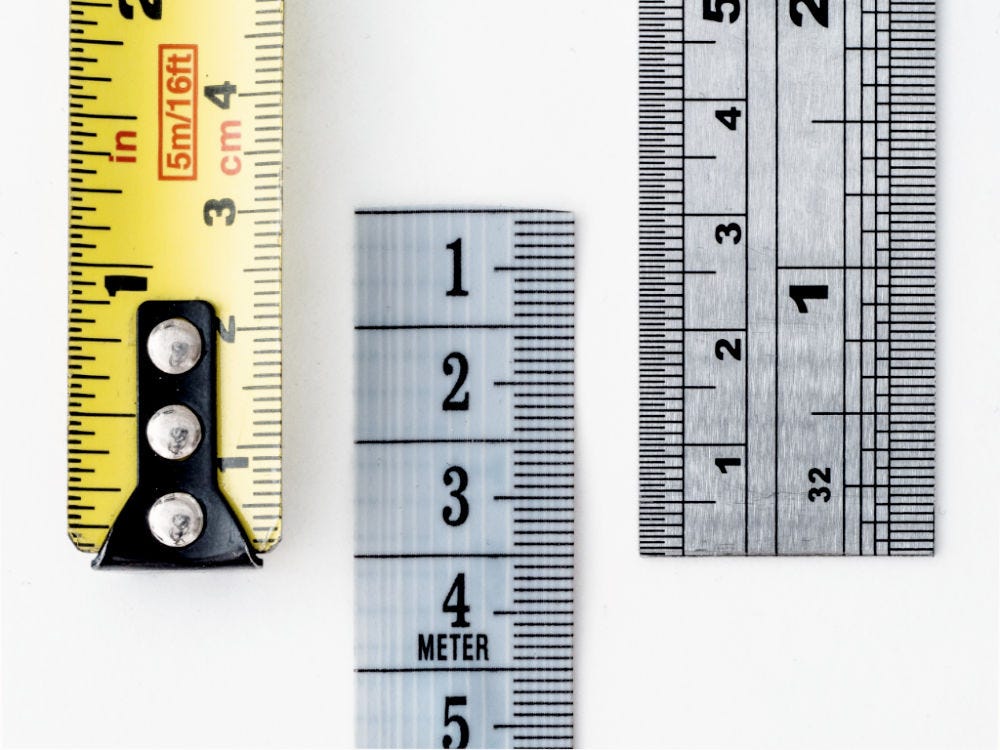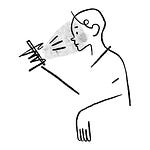St. Benedict of Nursia created a rule of life for his monastic community, and over a thousand years later we still look to it for inspiration. In this episode, Tsh walks Seth through a method of creating his own personal rule, one that he can tweak and adjust for the rest of his life — and you, dear listener, can do the same. After all, a Rule of Life is simply “a commitment to live your life in a particular way,” which means it’s a stellar tool for helping you say yes and no to the right things. Tsh has been leaning into this practice since 2014.
Seth: Newsletter | Twitter | Instagram | Website
Tsh: Newsletter | Twitter | Instagram | Website
Support the show — buy the next round of drinks!
Subscribe to the show’s Substack
Tsh’s Rule of Life workshop
Courtney Dauwalter documentaries: The Source of the Will and An Almost Perfect Race
Scroll down for the transcript
Seth: Welcome to A Drink With a Friend, I am Seth Haines.
Tsh: And I’m Tsh Oxenreider.
Seth: Tsh, what are you drinking?
Tsh: I don’t remember if we’ve talked about this mocktail, I feel like we have. I am drinking this thing that makes some people gag. It is apple cider vinegar and lemon juice and salt and water.
Seth: Salt?
Tsh: A tiny pinch of salt, like a three-fingered pinch. I’m doing some intermittent fasting for a variety of reasons and this is a good thing to have for electrolytes and for science-y reasons. I actually think it tastes really good and just read today that if it tastes good that means your body needs it, it has to do with acidity or alkaline or something. If it tastes bad, maybe your body doesn’t need it. Maybe that was their way of convincing you that it’s healthy. I think it tastes really good.
Seth: If you think Diet Coke tastes really good, is that your body?
Tsh: No, this is just for this drink. It’s a doctor who is saying specifically for this drink, he says, I know it sounds gross but it’s actually really good if your body needs these things, apple cider vinegar in particular.
Seth: I’m a big fan of shrubs. A shrub is a sipping vinegar so it has a lot of those same characteristics and when I stopped drinking, I drank a lot of shrubs and tonic or shrubs and soda water. It has that same flavor profile. It’s fantastic.
Tsh: I believe you. To me, it tastes like a whiskey sour. I get it. What are you drinking?
Seth: I am drinking Airship coffee from my local Red Kite coffee shop. Sometimes they’ll brew different kinds of coffee and today I am drinking Airship. It’s really good. I don’t know which one it is because they just said that’s what they are brewing and that’s what I got.
Tsh: Cool.
Seth: It is great. I finding more and more that I have these two amazing local coffee roasters. They’re completely different and I can almost taste the difference in their roasting techniques. I think I can do it blind at this point.
Tsh: That’s a sign of good coffee if you can taste the nuances like that.
Seth: They’re both so good at what they do. Onyx has a national reputation but Airship, they are doing amazing work locally. I appreciate it.
I’m really excited about today’s episode and I actually think that of all the episodes we’ve done, the listeners, YOU, dear listener should be most excited about this with me because we are going to school. You are going to school me today. Are you excited about schooling me?
Tsh: Yeah. Actually, this is good for me, too. I’m a student alongside of you.
Seth: A lot of people know this, I’m an attorney by trade but I’m also a ghostwriter and a co-writer. What that means is that I have a lot of practice in taking narratives apart and putting them together and organizing them in ways that make for books. I do this for other authors, I do it for myself. We’ve worked together on some stuff before. This is a thing that I love to do. It was a couple of weeks ago, I was doing a storyboard for a client and it struck me that the same way that we build storyboards, we start from nothing and look at the pieces of a person’s life or the pieces of a person’s story, what they want to do, what they want to say, and we build a storyboard block by block. It struck me as I was doing that that in the same way we do storyboards we ought to do this for our life. We ought to step back, look at the arc of our life and say, okay, here’s where I am today. In five years, where do I want to be? How am I going to get there? How do I storyboard this process to be where I want to be five years from now? This weekend, I did another one and I was flying back yesterday and a friend of mine called me and I was talking to him through this very thing and he said, I’ve been thinking something along the lines of that but really what I’ve been thinking about more is creating a rule of life. The minute he said it, I was like, oh yeah, I have needed to do that for years. I’ve never done it. I don’t really know how to start and then it occurred to me, that I do know someone who has done this, and done this well. And I am talking to her today. Tsh, what is a rule of life?
Tsh: The simplest answer is a rule of life is a commitment to live your life in a particular way. It was first created, the first one we know of, is from St Benedict of Nursia which was in the 500s, a long time ago. This is a practice that has been around for a long time. We consider him as a father of monasticism. He was the first one to say, hey, we’re all these desert fathers and mothers, we should live in community instead of on our own. What he did was he gathered people, he was a natural-born leader, but then he realized we need some system or else it’s going to be Lord of the Flies monk style. He created a rule of life that is still in print today. You can get it. I have a copy. It’s written with a modern translation. What it was is just explaining the why and how of what they did. Have you ever read it? His rule of life?
Seth: Oh, I thought you meant Lord of the Flies monk style.
Tsh: [laugh]
Seth: I have read both the Lord of the Flies and his rule of life, yeah.
Tsh: His rule of life, I find it, honestly, mildly humorous because he gets into some really deep why stuff like why we do what we do but then he gets into some really practical stuff like the person who stands at the front gate will be here and have this scroll, or whatever it is. He gets into the how, too, some nuts and bolts. The reason he did this, and he gets really granular and really specific, is to give them a framework for how to live out their monastic life. The idea of doing one now obviously, most of us aren’t monks but most of us do live in community, at least we should I would argue. Most of us live in community whether that’s our families or neighborhoods or roommates or whatever it is. It’s a good idea to write a rule of life even if it’s a rule of life for just us and maybe not necessarily a community like a family so that we know the whys and hows of what we do, what we do. Those whys and hows translate into, honestly, what you should say no and yes to. That’s the short answer of what I tell people when they ask why should I do a rule of life. My answer is simply so you can know what to say no and yes to, because there’s a lot of opportunities out there and how do you know. And most of it is good.
Seth: Before we get into the details and how to do that, tell me or explain to me what’s one thing that your rule of life keeps you from saying yes to or makes you say no to?
Tsh: The way I’ve broken down my rule of life, and it’s not a requirement, it’s just my way of keeping it simple and streamlined so I don’t feel overwhelmed is, psychologists and sociologists have basically determined that most of life can be broken down into six domains, six categories. Mine are in those six categories. An example I have is, I’m looking at it right now, is under for example community, I put that we regularly evaluate the value of the things we participate in. That’s a statement in my rule of life. What that means is if one of my kids says I want to do youth theater for this next show, we will evaluate that every time. Meaning we’re not saying, great, you’ll do theater for the next five years. We’ll say, sure, you can do theater for the next nine weeks for this particular show and then we’ll regularly evaluate it because that’s a high value of ours that we are continually coming back. That’s just one example of many. Community is one of those six life domains. That’s why it’s under there.
Seth: What are those six life domains?
Tsh: I’m glad you asked. The six are, and they go in order for a reason…the first one is work and vocation, second is health and wellness, third is relationships, fourth is community (which is different that relationships), fifth is money, and sixth is home. I saw they’re in order, at least the first one is, the reason I evaluate work and vocation first is because Gallop did this survey of all sorts of, it was a massive survey back in the day when they were developing your Strengths Finder concept, and what they found is that across different cultures, across different demographics of people, no matter who they were or where they lived, the number one factor that determined whether someone felt like they were thriving versus surviving was their work.
Seth: Wow.
Tsh: I know. I thought that was really interesting. Not their wealth, not their health, not their marriages even. We start with that and we move forward. I’ve come up with a system based on my own experience because I first did this in 2014 when my family and I were backpacking around the world all the way to I’ve revisited, tweaked the “system” all the way to now that I teach this to my high school students and I’ve had some training in some coaching practices and it’s what I do with other people now too. It seems to be a good system.
Seth: The rule, the system that you’re calling is also known as your rule. Your rule is constantly under revision? Is that fair? Is it a thing that you revise and work on and it’s not locked in stone?
Tsh: Right. I call it a living document because it’s not locked in stone. I haven’t cross-stitched it on a pillow. It is a thing I visit, for me, I just naturally visit it twice a year which is on my birthday and at the new year. My birthday in the summer so that’s a halfway through the year break. I don’t have a rhyme or reason. I’m actually revisiting it right now because I’m working through it with some juniors and seniors in high school so it’s a good time for me to look at mine again and see what it’s about. It’s always in flux. The reason is that it really does address two things, the why and the how. Our whys tend to not change too much but our hows do because we’re in different seasons of life. If right now my rule of life addresses what kind of parent I am and what that might look like, I might still care about parenting in the same way, my why. But the how is going to look different in ten years because kids will be older. That’s why it’s a living document. It’s good to not think that this is what God hath said about your life now and forever and ever.
Seth: It’s something you’ve done since 2014. I remember the first time you told me about it, I thought it was very intriguing, not because I had never heard of the idea of a rule of life but because it was something that you were actually doing. I think you’re actually the first person I know that had a personal rule of life. I know a lot of people have goals and they do goal setting and goal sharing and they may have a value list or they may have a purpose statement, but tell me what’s different about those things in a rule of life.
Tsh: In some ways, there is a little bit of a crossover because I also have a, I hate the term mission statement and I’m sure most people listening do too, but I do have a one-sentence synopsis of my work, why I do the work I do that just helps me. The main difference, honestly, is that how bit. Therefore it makes it a little bit longer. It doesn’t necessarily have to be very long but for me, the rule of life gets into the nuts and bolts a lot more. I’ve worked out three steps. The thing that makes it different from a mission statement is I think a mission statement would just stop at the second step. A rule of life takes it all the way to the third step which I can tell you about in a minute. That’s why. It gets really granular. I can look at it and say, oh no, that’s not for me right now when I’m given a good opportunity to write something as a writer or to speak at a conference. It gives me boots on the ground stuff.
Seth: It’s what I call, when I’m working with a client we try to get really granular with a client’s storyboard or because it provides what I call gates and filters. These are the things that we will talk about, these are the things that we won’t talk about. We filter out the stuff that’s superfluous to the message. It sounds to me that’s what you’re saying. You have this overarching message, this mission statement and that’s the communication but when you get into the nuts and bolts, this is what I will pursue, this is what I won’t pursue, this is how I will evaluate what I will and won’t pursue and it sets up those gates and filters. Is that a fair way to think of it?
Tsh: Yeah. It’s exactly right. If you want to take it full encapsulating what we do here on this podcast, it helps you name what you believe to be true, good, and beautiful, to be honest. Or at least what matters most to you within the realms of true, good, and beautiful. It’s the thing I write in my journal and I scribble out and scratch. It helps you wrestle with these things and it helps you realize, oh, this matters to me even though this thing is good maybe it’s not for me. The gates is exactly right. It’s what you let through.
Seth: You teach this now to kids, your high school students. Can you expect a high school student to even know what they want to eat that day much less what their rule of life is? How is this even possible? I have a hard time with this one.
Tsh: Heck to the no. This is my first time doing it with high schoolers so they are my guinea pigs because I want to work through what does this look like for a high schooler? Not so much because they need to draw a line in the sand and say this is what I’m about. It’s so that they can build this habit of doing it the rest of their lives because it’s a living document. It’s going to be a mess. They’re not going to get it right. In fact, I’m hoping that in twenty years they’ll look back and laugh at their rule of life that they wrote when they were sixteen thinking that that’s what they cared about.
Seth: But the hope is, too, maybe one or two of them will stick with it. How does one create a rule of law because I have not done any rule of law for forty-three years now? If I were your guinea pig, how would we go about this?
Tsh: I like that you’re my age, we’re both forty-three. There’s something about this age that feels itchy. I don’t know if you get this way. Anybody listening can do it. I would argue, maybe not younger than sixteen because what’s the point? Anyone at any point can do this but there’s something magical about the forties I feel like because when we first start the forties, we’re halfway to eighty, which maybe not quite halfway through life, so we still try to claim a little bit of that “we’re on the young side”. Thinking memento mori, remember you will die. I think that rings so much truer once you hit forty because you realize, holy cow, I’m halfway through more of less. I don’t know if you feel that way. I certainly felt that way the past few years so my rule of life has meant more to me now that I’m in my forties that it probably would have when I was in my twenties.
Seth: I definitely feel that. In fact, when I turned forty, it was probably the year after I turned forty, I started getting this itch to engage in different ways of service and I was in a church context at the time that wasn’t super interested from a leadership perspective of finding ways to serve or at least wasn’t serving. I kept saying, look, man, I’m in the second half of my life, I don’t have time to sit around and talk about ideas, ideas, ideas. We have to be about doing and moving and being in our bodies and there’s something really functional to life that is only true, ideas are only true as far as they’re put into practice through our bodies. I feel like if I had had a rule of life when I was forty and could evaluate these things, yeah, ideas are still great, ideas are still important, but what are you doing about those ideas? How are you living into those ideas? How are you putting gates and filters up so that you can pursue ideas in your body? Help me figure out how to create a rule of life so that if I’m ever in that situation again, which I won’t be in that situation, thank goodness, I’ll know how to say that’s not in keeping with my rule of life.
Tsh: Here’s what we’re going to do. People know because they listen to this podcast that I have a rule of life audio series. Anybody can get, you pay what you want. You can pay literally a dollar for it if you want. I think that’s the lowest. It wouldn’t let me do it for free. Anybody can do this if you want.
First of all, take a quick snapshot of your life in three years so you have some specifics that you’re imagining. First thing, Seth, think about in 2024, because we are talking in 2021, three years from now, think about how old you are, and what you’re living situation is and anything else you might want to know so while you’re thinking through that and it’s going to be similar to yours. For me, I put I’m forty-six, I live in the same house in Georgetown and I live with my family. This is what stopped me in my tracks, my kids are nineteen, sixteen, and almost fourteen. That makes me want to puke a little bit because I can’t believe my kids would be that old but that’s only three from now! It’s good to remember that. Jot down those thoughts.
Seth: Do you want me to answer those questions?
Tsh: Yeah, you can do that.
Seth: I will be forty-six, same age, I had to do some math but you already told me the answer. I don’t think we’ll live in the same house. I think we will have built a house on a piece of property outside of town in Goshen. One of my kids, if not two, will be out of my house. I’ll have a sixteen-year-old and a twelve-year-old still in my house.
Tsh: Crazy, huh?
Seth: That’s crazy.
Tsh: That is crazy. It’s only three years away. You know how fast that’ll go. That’s helpful to think about. You then think about these different domains. We’re not going to have time to go through all six domains. I don’t know how you feel but you can plug and play this concept with all of these domains. If we want to do the work and vocation here on the show?
Seth: Okay.
Tsh: I want you to think about how are you flourishing three years from now in your work and vocation? You can jot down thoughts. I think verbs are important. To write them with verbs, not just describe feelings. Think of it almost in the present tense. What are you doing now? As you’re writing or as you’re thinking through, I can share mine.
Seth: Do it, yeah. Go for it.
Tsh: Okay. I put on mine, these are just notes. This isn’t your rule of life yet. I spend most of my energy (it was time and I changed it to energy) doing work that I enjoy that uses my gifts and that pays equitably. I write daily. I’ve published a novel and I’m working on a second one. I continue to lead Literary London and I am brainstorming a non-London trip. I volunteer monthly in my local community. I work for pay less than forty hours a week. That’s what I wrote down.
Seth: That’s good.
Tsh: Just shoot off a few thoughts about what do you think work and vocation looks like for you three years from now.
Seth: I think I’m using my training as an attorney and a storyteller to help solve my clients’ problems, whether those are legal problems or marketing and advertising problems, or storyboarding messaging problems for books. I’m using my legal skills and talents and my storytelling skills and talents to serve clients. One of the things that I’m not really good about and maybe we could follow back up on this one day, is I’m not really good at the money side of things.
Tsh: You don’t work for free.
Seth: You don’t work for free. The truth is if I look at the things that I value, I value creativity and collaboration. If you were to look at my mission statement, creativity and collaboration would be in my mission statement and they are my top two values. The problem with that is I have a family to feed. Amber is always saying, if she’s listening, she is always saying, yeah but, there’s a cost to associate with those things. There’s a value that you need to peg to creativity and collaboration and you need to make sure you are getting your value. There probably needs to be a piece in there for me about identifying value, whether that’s general value, I’m making enough plus ten percent to save for my kids to go to college. Whatever that thing is, I don’t know what that number is. Or whether that means that I’ve created a business and sold it for $7 million dollars. Which that’s not a thing. There probably does need to be a value piece in there.
Tsh: It’s good to remember that obviously, you’re not a soothsayer, you don’t literally know what’s going to happen. You could have a business that you sell for $3 million, $7 million, whatever you said. Who knows? It’s good to imagine based on reality and that’s when I get into when I say that this isn’t woo-woo. We’re not talking about imagine your best life and it will come true. What is that, there’s stuff on the internet that’s just ridiculous about thinking your way to whatever it is you want. This isn’t that at all. I’m not at all implying, for me, that in three years from now I’m going to be paid eight figures for my writing. I’m being paid equitably. It’s grounded in reality. The other thing is that none of these domains are actually clear circles with lines that stand separate from each other. If you imagine a Venn diagram, it’s a really messy Venn diagram because another domain is money so that’s where I get into things about what we spend our money on, what we care about, what we prioritize, how we save, what we invest in, that kind of thing. There’s some overlap with work and vocation there. This is why this is a living document because you start thinking through all sorts of…in fact, when I was just looking at mine this afternoon, I don’t actually feel as strongly about that anymore and I took it out, a thing. It changes all the time.
Seth: To go back, if we’re working this exercise and I think the listeners, hopefully, they’ll be sitting down and working their own three to four statements. They’re envisioning their work and in three years what are those three to four statements. Like you, I think I would like to have a novel published. I do have a novel right now sitting with an agent. We’ll see if that’s the one. Maybe it won’t be? Maybe it’ll be another one. I would like to see that published and I’d like to be working on another one. The big one for me from a work perspective is that I will be continuing to pursue new ideas. I think that’s really important for me. Just to say that just because I have achieved something or just because I’ve understood something or know something doesn’t mean that I quit. I keep trying constantly to pursue a new idea in that same realm and to continue to get better to be the best version of myself that I can be in that realm. I think that’s a thing as I look at your list, work, health, relationships, community, money, and home. I know that’s an amorphous concept but even in the health bucket. If I were to look at my life in three years in the health bucket, I’m really intrigued lately by the concept of a hundred miles on foot. I don’t think I’ll ever go a hundred miles on foot but maybe I’ll go fifty? Does it have to be specific or can it be something like in the business space, continuing to learn, being a constant learner. That’s up in the sky, it’s an idea. In the health and fitness, it may be a lot more granular for me, by three years from now I want to have fun a fifty miler or something.
Tsh: At this step, everything can be lopsided. You can have some really specific ideas about your home because you have literal blueprints or it could be something as vague as something as I want to move out from my parent’s house by then. Something like that. Everybody’s different. Everyone’s got a different situation. This is just step one. Because it’s a Venn diagram, I like that you brought up what you did because I think there’s a pretty heavy overlap in work and vocation and health because I define health as body, soul, and spirit. To me, that includes hobbies. I think I’m healthier when I have a hobby. To me, learning and reading actually go under health just as much if not more as vocation. I think it makes a lot of sense that it’s pretty amorphous, especially at step one here.
Seth: Let’s say this, I now I have my, and again we’re just working the work run, I now have my three to four to five, however many statements. What do I do with those statements?
Tsh: The next step is, St Benedict had both why and how statements in his rule of life. I break that down into my 21st-century brain as rhythms and rules. The rule gets into the how but the rhythm gets into the why. It ends up translating to statements of being that I value most to me. The way I get to those statements of being is I take each one of those things that I just jotted down and I ask that classic toddler question, why? I keep asking it until I feel like I’ve hit the end of my true that’s why. I’ll give you an example. My first one under work and vocation I jotted down that I spend most of my energy doing work that I enjoy, uses my gifts, and that pays equitably. I ask, why? I said because it’s the best use of my time and energy rather than trying to improve my weaknesses or gifts that I’ve just never had. I ask again, why? The reason is because I believe God has given them to me for a reason, my gifts, skills, the work. Why? Because I believe my life has a purpose. Why? Because why else would I be here. My existence assumes it. To me, that’s where I stop. That’s my why. The reason I spend most of my energy doing work that enjoy and uses my gifts and pays equitably is because it’s part of my core purpose because why else would I be here. These are skills and gifts that God has given me and that they have to tie in. I do that with every single statement. I keep asking why.
Seth: Okay. It seems to me that for instance on that one when you drill all the way down to the bottom of your why, you’re almost getting to a core point of gratitude.
Tsh: Yeah. You kind of are. This ends up being a form of therapy in a way because you realize, wow, I have a lot and I’ve been given a lot.
Seth: Talk me through the why of you want to have written a novel.
Tsh: Okay. I’ve published a novel and I’m working on my second one. Why? Because I enjoy storytelling. Why? Because I personally enjoy learning through stories and I think others do too. Why? Because humans seem to be hardwired to love and learn through stories more than any other tool. Why? Because God made us that way. That’s what I got to.
Seth: There you go.
Tsh: Yeah. There you go. For me, I’m working in fiction because of the storytelling and I think there’s a divine purpose in storytelling. Again, this gets into my, oh, this is part of my core purpose, I think. At least this idea, this intersection with the skills and the desire that enjoy it. It’s helpful for me to name the fact that I enjoy things because sometimes I don’t give myself permission because I like it. We try to make it too…we need it to be useful and we forget sometimes that it’s okay that we just do things because we like them.
Seth: Okay, that’s good. For me, it’s funny. I think I would say the same thing about storytelling. When I say why do I want to write? That’s a good question. Why do I want to write? One, I just love it. Maybe mine’s a little bit different. I love telling stories, whether they’re fiction or non-fiction or even through a poem. Whether or not anyone here ever sees it or reads it or whether I just do it for myself. The question there would be, why? I feel like that’s the most like myself that I am is when I’m writing. It feels most myself. If I want to why below that, I would say because I feel most connected to God even if I’m not even writing anything spiritual. To me, I don’t know that I can not tell stories. That’s a different thing than why do I go make money? My way for making money is to feed my family.
Tsh: Right. I think you’ve gotten all the way down to your why because you’re made that way. This is how you are made. You can’t not tell stories. It sounds to me like, or that if you don’t you’re less than human or you’re less whole maybe is a better way to put that.
Seth: Yeah, less whole.
Tsh: You have acknowledged that one and you do that through all of these. Once you do, you take this information that you’ve now unearthed and you create statements of being that hold true to you based on this information. Under work and vocation, what I’ve done is that I take these ideas from blue sky to describing the soil in which my tree is flourishing and under work and vocation, for example, I have, I value and cultivate my skills and interest because they matter. I prioritize storytelling. I believe specific places on earth hold sacred value (that’s my trip leading). I believe people’s souls are the reason for my work. I value being paid well for hard work. I thrive because I balance my work time with regular rest and play. That’s still a lot. We’re not done yet, but those have now become things that I am noticing are true about me and that’s what I mean by statements of being versus statements of doing. These are my whys. We’re still not at the rule of life but at least it’s helpful to see, oh, there are reasons for why I want to do those things in three years’ time.
Seth: You summarize your statements of being and you put them all in one place so that you can look at them together?
Tsh: That’s right. I take all those whys and I just made them a little more cohesive, it’s still a lot of words but yeah.
Seth: Good. That’s step three.
Tsh: No, that’s step two. Step three, remember you’re doing this times six. You’re doing this will all of these areas. It’s long.
Seth: Yep.
Tsh: The next step is to take, you’re going from the why to how. This is what becomes a rule of life. You take your statements of being into statements of doing and what you’re doing is looking at what does it look like, now that I know my whys, what does that look like for the next year, or for the next six months? It’s all well and good to say I want to be able to run or hike or whatever fifty miles but because I’ve acknowledged the why behind that then what does that look like now? Does that look like running a mile every day? Does that look like spending x amount of time outside? Whatever it might look like. You’re getting into really specific right now. Then what you do is you take the specific to now and you recognize these are the things that actually ultimately matter to me. What I have put, I know I’m jumping ahead, but what I’ve put in my rule of life right now, we’re talking spring 2021 under work and vocation for me…I have four value statements. I value my vocation as a wife and mom above my other vocations. I filter my publicly shared work through the lens of what’s true, good, and beautiful. I prioritize creating long-form work that will last over short-term, trendy work. My work is in its rightful place when it’s in tandem with rest and play. Those are actually parts of my rule of life right now.
Seth: That makes total sense. You’re essentially saying now that I know who I am, what my why is, it’s sort of this idea of know thyself, right? Once you know yourself, you know why you are the way you are. Why you have the goals you do or why you envision your life, you storyboard your life so to speak, a certain way. How do I put that into practice to make sure that I’m realizing the why? Just letting life happen. Life is still going to happen, like you said. The pandemic, no one saw that coming. Life still happens. It still mucks around with your rule of life but at the end of the day, you’re at least taking a proactive approach and also I would assume, and maybe not, but I would assume you believe that place matters, you love this Literary London tour that you did. I love the idea of it, I think it’s incredible. If you have something like a pandemic or an injury or sickness or something that threw your three-year plan off, you could say, okay, maybe I can’t do that but here’s what I can do to still do the why. An example of that, I know someone who was very excited about the idea of walking the Camino. What she did was still walk the Camino, she did it through a virtual app. It would walk a certain amount of time and it would say now you’re here and give you a virtual tour of where you would be had you been walking those mountains on the Camino. It wasn’t a good replacement necessarily but it was still of way of saying my rule of life says that I need to want to go on pilgrimage and I can’t do that because life has intervened but here’s what I can do as a stop-gap or supplement to still walk into my why, no pun intended. Or maybe every pun was intended there.
Tsh: I think that’s a great example. That’s funny, I didn’t even know that app existed. I like that you brought up this whole topic with the idea of storyboarding and stories. I don’t know about you but I roll my eyes hard at that statement that’s been around for a decade-plus now, especially in Christian circles which is “live a big story”. I used to like that idea but I don’t anymore. I think something that a rule of life gets to is the idea of living your own story. If we are in a story, if we want to take this analogy in that we have rising action and denouement resolution, it just better be your own. It can be really small. I want to live in this tiny house in three years. I don’t have visions of anything bigger than that but I want it to be mine. I want to be where I’m supposed to be.
Seth: I love that idea. I am with you. I think living a bigger story is a sign of our narcissistic egocentric age. It seems to me that creating this rule of life is the thing that would help us to get to the true life. To recap, make sure that we have it. Make sure readers (listeners) understand and that I can go off and do this on my own and maybe do it with my friend. We have these six areas that we’re going to look at. We’re going look at work and vocation, health and wellbeing, relationships, community, money, and home. Once we have those buckets we’re going to sit down and look at our lives in three years. We’re going to be very specific, use some verbs in step one for each of those buckets. This is where we see ourselves in three years. Step two, we’re going to create these statements of being. We’re going to drill down through the whys and say this is who I am which is why I see myself here in three years. Step three, we’re going to say these are our statements of doing. This is what I’m going to do about. This is how I’m going to pursue it. This is what I’m going to do about it this year to make sure that we’re on track to get to that place. Anything that I would imagine that is a distraction from those things, this operates as our gates and filters. If I want to write a novel or publish a novel in three years and somebody comes to me and says, oh, you’re a writer, why don’t you write a column for this magazine for the next three years and it doesn’t advance my goal of getting my words in for my novel then I should say no.
Tsh: Right. This is why I put it in my journal, to be honest. I need it front and center. It’s not like I look at it every time, what toppings do I want on my pizza? It’s whenever I’m at a crossroads and I really need to decide, gosh, do I say yes to this opportunity or now? I need to look at it because I know these things. Nothing I said was like, oh my gosh, I never knew this about me. But we forget, in the midst of, especially when we’re looking at something shiny and pretty and lots of other people are doing it. It’s easy to forget these things.
Seth: That’s good. I love it. I think maybe you’ve helped me pin down one of the reasons why I don’t like these pithy Instagram quotes because I value true, original creativity and collaboration. If that’s true, I’m always going to be making something new that’s creative. It doesn’t mean that’s wrong for someone else to do, it just means I’m never going to do it even if it sells well or builds a following. I’m not going to do it because it’s not part of who I am. It’s not part of my why.
Tsh: For me, learning or recognizing, acknowledging that I prioritize long-form work that will last over shorter-term trendy work, truly helps me say no to so many ideas that I have. It’s not even opportunities that someone else is bringing me, but ideas that I come up with in the shower. I know how to xyz out on the internet. I can play the game of social media or creating yet another course online or doing whatever. But when I remember, wait, for me, that might be good for someone else but I actually care about long-term work that will still be on a shelf in fifty years. That means I’m going to make more time for that book writing than I am for creating a thing but that’s just how I’m wired. It’s good for me to remember that.
Seth: This has been incredibly instructive. I’m very grateful and we’ll check in maybe in six months and see if I’ve got a rule that’s kicking around, alive and breathing. It’s alive! Maybe we’ll play that clip or something?
Tsh: We’ll have Kyle slide that in.
Seth: As a final word, I’m going to have notes. I’ve taken some notes here and we’re going to slide those into the Substack for those of you who are in our Substack community, it’s going to be our first offering. We’re going to do other stuff. Essays, creative stuff. But this is going to be a way that you can look and see in real-time, these are my notes that I took from Professor Tsh.
Tsh: [laugh] Right.
Seth: Tsh, what is one thing that you are reading, listening to, or watching that is bringing joy to your life?
Tsh: Have you guys watched The Chosen yet?
Seth: Oh my gosh. Yes.
Tsh: Season 2, Episode 1 just came out Easter Sunday, a few days ago. I loved it. Did you watch it?
Seth: We have not watched it yet because I was traveling so we’re saving it to view together.
Tsh: Got it. It was delightful. I thought it was even better than the stuff on Season 1. I really liked the creative storytelling, since we’re talking about that, aspect of…no spoilers, but how they decided this particular gospel came into being was so fun. I loved it start to finish, it was fantastic. If you haven’t yet watched The Chosen, you’re just like me if you tend to eye-roll these things. I get it. I think this is legitimately good. It’s free. It’s currently on YouTube but you can also download the app and watch it and Chromecast it to your TV and that’s how we do it. The Chosen is still really good. What about you?
Seth: I eye-rolled that really hard. I’m not going to lie to you. People kept telling me to watch it and I was like, okay, okay, sure, whatever. I’m kind of cynical, so there’s that. But finally, I woke up one day and I was like, you know what, I think my kids need to know the stories a little bit better and I don’t know how to do this other than just sit them down and start reading the stories which tends to lose them or they start making fart jokes because I live in a house will all boys. Instead, we got really intentional over Lent and we sat down and said we’re going to watch The Chosen. I was blown away at how good the storytelling was and particularly, I know everybody talks a lot about Peter, but particularly the two characters of Mary Magdalene and Matthew. The Matthew story and the arc and the resolution of Season 1. If you don’t cry when you watch that, regardless of if you’re a Christian, a person of faith or not, then you’re literally not human. It’s so good.
Tsh: It is so well done. My kids have all said, I don’t know how your kids felt, the series makes these people feel like people and not just nameless, faceless names in the Bible.
Seth: That’s good, I like that. I’m looking forward to watching the first episode. I think we’re doing that tonight. Thank you for not spoiling it.
Tsh: You’re welcome.
Seth: I have been watching…for mine, I have been watching running documentaries like crazy. I’m a cross-fitter.
Tsh: I thought you hated running?
Seth: I do hate running. I’m super intrigued by this idea of trail running at least a 50K, which is thirty miles and change. I’ve been watching these ultra-marathoners that do trail running and there’s this one, in particular, her name is Courtney Dauwalter. Courtney Dauwalter is just a delight. When you watch her run and you watch her talk about the agony and also the ecstasy of running, you can see that this is a thing that gives her life and joy and that she was literally made to do this thing. I think it fits with what you’ve said about the rule of life today which is know who you are and why you’re made to do the things that you’re made to do, pursue those things with great intention and excellence but when life happens, hold to it loosely and revise your goal and back it off if you need to back it off. There’s just something about it to me that been very freeing. It’s watching her and a couple of others do that has made me think there might be something here for me to learn. That’s why I’m mining that mine so to speak right now.
Tsh: That’s really cool. As you were saying that and as you were talking earlier I got to thinking we need to do an episode of this show on the idea of partial solutions because if people have been following me at all in the past twelve years, they’ve heard me say this at least once, that has been a game-changer for me who has perfectionist tendencies. This idea of all or nothing, zero-sum living that is just impossible to achieve that people like her, need to teach me what that looks like to adjust on the fly but whenever you just lost, what does that mean to not say screw it, I’m going to watch Netflix for the rest of the afternoon. That’s really good.
Seth: I think what Dauwalter does that I love so much is she just shows there’s actually a middle ground here. We do things hard. We push ourselves. We try to do things that are uncomfortable and to achieve really big things with excellence but when we can’t or when we don’t or when life does what it does, we also say, maybe tomorrow. Maybe today wasn’t the day.
Tsh: That’s really good. That’s cool. That’s a whole thing that we can unpack sometime about not only how that affects us but how we view other people because I see in our culture now almost the pendulum swing reactionary from not wanting to live a big story to mocking anybody who cares at all about anything like CrossFit or doing something balls-y.
Seth: And to be frank, and we can do an episode on this, I’m just tired of it. I am to the point in my life, unapologetically going to pursue excellence.
Tsh: That’s good. I like it. That’s a great way to end this.
Seth: Yeah.
Tsh: We, as forty-three-year-olds are going to wrap this up. You can find this episode, as well as all episodes, at adrinkwithafriend.com. It’s also where you can sign up for our new Substack space for the show, where we have plans for some pretty great extra stuff for you, and it’s also where you can support this show for just a few bucks. If you like what we’re bringing to your earbuds, we are almost 100% listener-supported and we like it that way — so again, all this is at adrinkwithafriend.com and in the show notes of this episode. You can find me and all my work at tshoxenreider.com and Seth, where can people find you?
Seth: They can find me at sethhaines.com.
Tsh: Music for the show is by Kevin MacLeod, editing is by Kyle Oxenreider, and Caroline TeSelle is our transcriber and assistant extraordinaire. I’m Tsh Oxenreider, and Seth and I will be back here with you soon. Thanks for listening.












